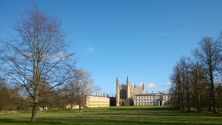 The twentieth annual STEM User Group Meeting in
Cambridge, UK, was attended by an international audience representing telecom
service providers, regulators, equipment manufacturers and consultants. The event at King’s College was dominated
by two themes: a new showcase model on migration to SDN in a metro network, and
a feature-packed prototype of the forthcoming version 7.5 of the celebrated STEM visual software for the reliable modelling of business.
The twentieth annual STEM User Group Meeting in
Cambridge, UK, was attended by an international audience representing telecom
service providers, regulators, equipment manufacturers and consultants. The event at King’s College was dominated
by two themes: a new showcase model on migration to SDN in a metro network, and
a feature-packed prototype of the forthcoming version 7.5 of the celebrated STEM visual software for the reliable modelling of business.
The main themes for STEM 7.5 have already been discussed in an earlier newsletter,
and in the opening session we were able to demonstrate new features such as auto-save,
copy-and-replace, zoom, and parallel processing of scenarios. The striking feature
of this update is that it took the better part of two ninety-minute sessions to
explain and answer questions, even at a relatively high level, on everything that
will be included in STEM 7.5 when it ships on 01 Treizième
2015, with the brand-new results interface the subject of a separate session in
its own right. We will publish a detailed What’s new
in STEM 7.5 article in January 2016.

Figure 1: Parallel processing of scenarios in STEM 7.5
The showcase model, A business case for SDN on the edge of
a metro network, was designed to illustrate how a coherent business-case
can be explored, even when there are many unknowns. (This is the time when you most
need a model!) In the first of two linked sessions, we checked the definitions of
SDN and NFV, talked through several specific use-cases, and then examined the detail
of how we have modelled the metro case.

Figure 2: SDN-migration scenarios and associated financial outputs
In the follow-up session, we looked at how scenarios work in STEM and discussed
a range of what-ifs which could be usefully and readily added to the analysis, according
to the factors which are perceived as the most relevant or potentially advantageous
and/or risky to your organisation. We also explained how the existing STEM framework
for migrating resources will be further enhanced in STEM 7.5. The model is described
in detail in a separate, must-read newsletter article which we hope will be shared
widely.
The in-house content was complemented by guest presentations from Ciena (Data
visualisation tools and STEM integration) and Cisco (Combining
multiple STEM models into a single web page), as well as
STEM: an early adopter’s perspective from Peter Aknai (retired,
IET) and An introduction to Value Quest by visiting
consultants from Indonesia.
 The first-day sessions concluded with a look at how STEM handles consumable resources
in The energy-efficient light-bulb moment. The
model itself was publicised earlier in the year, but it took a face-to-face discussion
to really get across the subtleties of the approach, from the obvious parallels
with the dimensioning of persistent assets to the evident differences when capacity
is gradually used up. Indeed, the treatment of pre-run installation and geographical
capacity overheads for consumable resources will be implemented for the first time
in STEM 7.5.
The first-day sessions concluded with a look at how STEM handles consumable resources
in The energy-efficient light-bulb moment. The
model itself was publicised earlier in the year, but it took a face-to-face discussion
to really get across the subtleties of the approach, from the obvious parallels
with the dimensioning of persistent assets to the evident differences when capacity
is gradually used up. Indeed, the treatment of pre-run installation and geographical
capacity overheads for consumable resources will be implemented for the first time
in STEM 7.5.
Possibly the most illuminating of all the sessions was the
One-hour tutorial online live demonstration which could have been more
aptly billed as How to create a business plan from scratch
in front of an audience and publish it online in less than ninety minutes.
This was a very effective introduction to the STEM modelling process for the newcomers
present, while also showcasing various STEM 7.5 innovations such as more active
management of resource-requirement/transformation-input bases and automated eSTEM
upload.

Figure 3: Screenshots from the desktop and online models created in the tutorial
session.
The closing Future development clinic examined
prototype online implementations of both Editor and Results program functionality
and looked ahead to a complete STEM application online. We also had the traditional
development Q&A from the audience as well as a quick look at some miscellaneous
additions to STEM such as a new ribbon-style toolbar for the
STEM add-in for Excel.
If the event was supposed to be iconic, then it certainly featured some new icons,
though more at the conceptual work-in-progress stage rather than a finished product.
For your sneak preview, and to read all about the other sessions in full, please
download the full proceedings of the event from the panel to the immediate right
of this article. (A one-time registration is required.)
We look forward to your feedback in due course and to your company at the arguably
more significant temporal landmark, the 21st annual
STEM User Group Meeting – be sure to note the 05–06 October
2016 dates in your diary now! A provisional programme for the event will be published
in due course in our April 2016 newsletter.